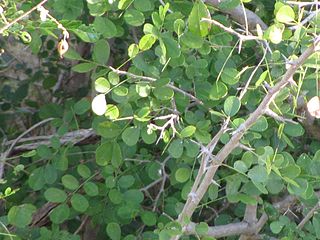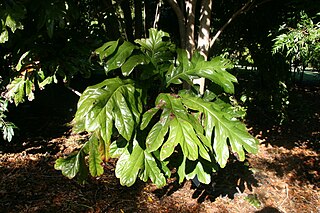
Dalbergia melanoxylon is a flowering plant in the family Fabaceae, native to seasonally dry regions of Africa from Senegal east to Eritrea and south to the north-eastern parts of South Africa. The tree is an important timber species in its native areas; it is used in the manufacture of musical instruments and fine furniture. Populations and genomic resources for genetic biodiversity maintenance in parts of its native range are threatened by overharvesting due to poor or absent conservation planning and by the species' low germination rates.

Heptapleurum arboricola is a flowering plant in the family Araliaceae, native to Taiwan and Hainan Province, China. Its common name is dwarf umbrella tree, as it resembles a smaller version of the umbrella tree, Heptapleurum actinophyllum.
Schefflera is a genus of flowering plants in the family Araliaceae with 13 species native to New Zealand and some Pacific islands.

Athertonia is a monotypic genus of plants in the family Proteaceae. The sole described species is Athertonia diversifolia, commonly known as Atherton oak, athertonia, creamy silky oak or white oak. It is endemic to a small part of the Wet Tropics of Queensland, Australia. A relative of the macadamia, it has potential in horticulture and the bushfood industry.

The whitetip weasel shark(Paragaleus leucolomatus) is a weasel shark of the family Hemigaleidae. Only one specimen, caught off Kosi Bay, South Africa, has been caught. That specimen was 96 cm long. In 2020, a fuzzy image believed to be this shark was obtained on the show Extinct or Alive.

An IUCN Red List Critically Endangered species is one that has been categorized by the International Union for Conservation of Nature as facing an extremely high risk of extinction in the wild. As of 2021, of the 120,372 species currently tracked by the IUCN, there are 8,404 species that are considered to be Critically Endangered.

Heptapleurum is a genus of flowering plants in the family Araliaceae, native to the Indian Subcontinent, Tibet, southern China, Hainan, Taiwan, Southeast Asia, Malesia, Papuasia, Japan, and Australia. It was resurrected from Schefflera in 2020.
Tetraplasandra is a no longer recognised genus of plants in the ivy family, Araliaceae. They are small to medium trees, of mesic to wet forests.
Heptapleurum albidobracteatum is a species of plant in the family Araliaceae. It is an epiphytic shrub or a small tree endemic to the Philippines. It is known from Cebu, Leyte, and Bukidnon and Agusan provinces of Mindanao, where it grows in montane forests. The species has an estimated area of occupancy (AOO) of 16 km2, and an estimated extent of occurrence (EOO) of 30,697 km2.
Heptapleurum sp. nov. 'nanocephala' is a undescribed species of plant in the family Araliaceae. It was placed in Schefflera previously. It is a tree endemic to Peninsular Malaysia. Its natural habitat is subtropical or tropical moist montane forests. It is threatened by habitat loss.

Heptapleurum taiwanianum is a species of flowering plant in the family Araliaceae, native to Taiwan, where it is scattered throughout coniferous forests at 2,000–3,000 m (6,600–9,800 ft). Growing to 4 m (13 ft) tall by 2.5 m (8.2 ft) broad, it is an evergreen shrub or small tree. Large leaves up to 15 cm (5.9 in) long are composed of up to 11 ovate leaflets arranged radially around a central stalk. Young leaves are covered in silver hairs, while mature leaves have a smooth surface. Sprays of flowers in late summer are followed by dark berries in winter - a valued food source for insects and birds.

Cardwellia is a monotypic genus in the plant family Proteaceae. The sole described species is Cardwellia sublimis − commonly known as northern silky oak, bull oak or lacewood − which is endemic to the rainforests of northeastern Queensland, Australia.

Heptapleurum racemosum is a species of plant in the family Araliaceae. It is a canopy tree that is endemic to Western Ghats of India.
Heptapleurum acuminatissimum is a flowering plant in the family Araliaceae. It is endemic to the Philippines, where it is known only from Bataan Province on the island of Luzon. It is a small scandent tree which grows in lowland rain forest at 700 meters elevation. It is known from a single location, and has an estimated extent of occurrence (EOO) and area of occupancy (AOO) of only 4 km2.
Heptapleurum acutissimum is a flowering plant in the family Araliaceae. It is native to Borneo and Sumatra.
Heptapleurum alongense is a flowering plant in the family Araliaceae. It is a climber endemic to the Hạ Long Bay islands in Vietnam.
Heptapleurum alpinum is a flowering plant in the family Araliaceae. It a shrub or tree endemic to Vietnam.
Heptapleurum angiense is a flowering plant in the family Araliaceae. It is a tree endemic to western New Guinea.
Heptapleurum heptaphyllum is a species of flowering plant in the family Araliaceae, native to southern China, Indo-China and Japan. It was first described by Carl Linnaeus in 1771 as Vitis heptaphylla.

Heptapleurum ellipticum, commonly known in Australia as the climbing umbrella tree, is a plant in the family Araliaceae native to the Indian subcontinent, Indochina, Malesia, Papuasia and Australia.










